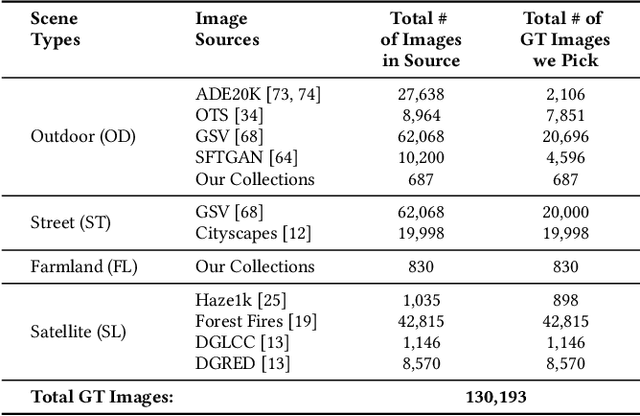Md Tanvir Islam
LoLI-Street: Benchmarking Low-Light Image Enhancement and Beyond
Oct 13, 2024Abstract:Low-light image enhancement (LLIE) is essential for numerous computer vision tasks, including object detection, tracking, segmentation, and scene understanding. Despite substantial research on improving low-quality images captured in underexposed conditions, clear vision remains critical for autonomous vehicles, which often struggle with low-light scenarios, signifying the need for continuous research. However, paired datasets for LLIE are scarce, particularly for street scenes, limiting the development of robust LLIE methods. Despite using advanced transformers and/or diffusion-based models, current LLIE methods struggle in real-world low-light conditions and lack training on street-scene datasets, limiting their effectiveness for autonomous vehicles. To bridge these gaps, we introduce a new dataset LoLI-Street (Low-Light Images of Streets) with 33k paired low-light and well-exposed images from street scenes in developed cities, covering 19k object classes for object detection. LoLI-Street dataset also features 1,000 real low-light test images for testing LLIE models under real-life conditions. Furthermore, we propose a transformer and diffusion-based LLIE model named "TriFuse". Leveraging the LoLI-Street dataset, we train and evaluate our TriFuse and SOTA models to benchmark on our dataset. Comparing various models, our dataset's generalization feasibility is evident in testing across different mainstream datasets by significantly enhancing images and object detection for practical applications in autonomous driving and surveillance systems. The complete code and dataset is available on https://github.com/tanvirnwu/TriFuse.
HazeSpace2M: A Dataset for Haze Aware Single Image Dehazing
Sep 25, 2024



Abstract:Reducing the atmospheric haze and enhancing image clarity is crucial for computer vision applications. The lack of real-life hazy ground truth images necessitates synthetic datasets, which often lack diverse haze types, impeding effective haze type classification and dehazing algorithm selection. This research introduces the HazeSpace2M dataset, a collection of over 2 million images designed to enhance dehazing through haze type classification. HazeSpace2M includes diverse scenes with 10 haze intensity levels, featuring Fog, Cloud, and Environmental Haze (EH). Using the dataset, we introduce a technique of haze type classification followed by specialized dehazers to clear hazy images. Unlike conventional methods, our approach classifies haze types before applying type-specific dehazing, improving clarity in real-life hazy images. Benchmarking with state-of-the-art (SOTA) models, ResNet50 and AlexNet achieve 92.75\% and 92.50\% accuracy, respectively, against existing synthetic datasets. However, these models achieve only 80% and 70% accuracy, respectively, against our Real Hazy Testset (RHT), highlighting the challenging nature of our HazeSpace2M dataset. Additional experiments show that haze type classification followed by specialized dehazing improves results by 2.41% in PSNR, 17.14% in SSIM, and 10.2\% in MSE over general dehazers. Moreover, when testing with SOTA dehazing models, we found that applying our proposed framework significantly improves their performance. These results underscore the significance of HazeSpace2M and our proposed framework in addressing atmospheric haze in multimedia processing. Complete code and dataset is available on \href{https://github.com/tanvirnwu/HazeSpace2M} {\textcolor{blue}{\textbf{GitHub}}}.
* Accepted by ACM Multimedia 2024
 Add to Chrome
Add to Chrome Add to Firefox
Add to Firefox Add to Edge
Add to Edge